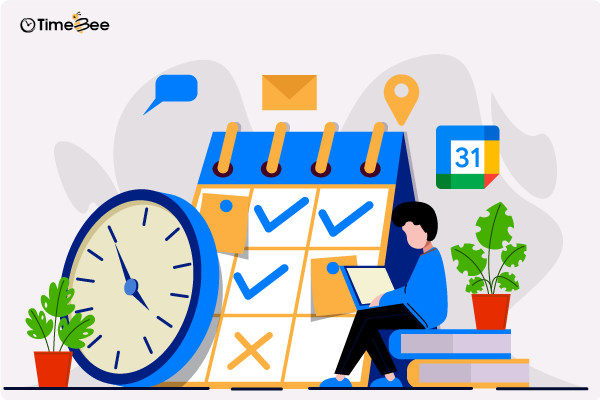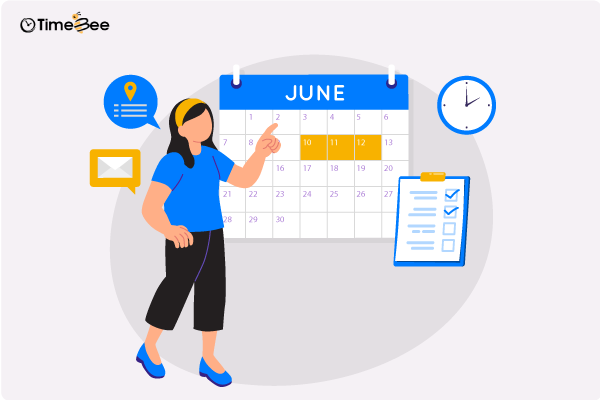Content
Content
You’re nearing the end of the day, glancing down at your to-do list before signing out. You’re immediately taken aback by the fact that you’ve only managed to do about half of the tasks for today. You experience intense frustration for not being as productive as you had planned.
Feeling disappointed? You’re not alone.
According to Voucher Cloud’s research, an average office worker is only productive for 2 hours and 23 minutes per day. Also, workers across all professions reportedly maintain an average of 60% productivity throughout the day.
It is common to struggle with your productivity from time to time. Every day is different. It is only natural to experience spikes in productivity, followed by lulls that could last a few days.
Maintaining a steady workflow is not intuitive or easy.
The good news is that there are plenty of ways to reverse the situation. We have crafted a list of the best tips experts share for conquering unproductivity.
Let’s dive right into them:
1. Get Proper Sleep
Let’s start with the basics: Get six to eight hours of sleep every night uninterrupted.
Maintaining a healthy sleeping routine is linked to improved productivity and elevated mood throughout the day. On the other end, having insufficient sleep affects the prefrontal cortex, the part of the brain responsible for logical thinking and problem-solving.
Safe to say, lack of sleep can strongly affect your productivity and leave you feeling grouchy all day.
We understand why it could seem difficult to get good sleep each day. Early-morning commutes, long working hours, and overhanging personal responsibilities may contribute to an increasingly insomniac workforce.
But if you think you’re doing yourself a favor by surviving on 4 hours of sleep each day, you could be pursuing what’s called toxic productivity.
2. Maintain a Healthy Diet
You are what you eat, and rightly so. A healthy body and mind go hand-in-hand to keep your productivity kicking.
If you’re serious about giving your best at work, you must make intelligent food choices. For example, snacking on a handful of sugary snacks will spike your blood sugar and eventually crash it. This translates into low energy and low productivity afterward.
The Productive Diet infographic lists a comprehensive list of superfoods for your brain, backed by CEOs and high achievers. Remember to include these nutrition-dense foods in your diet.
3. Exercise Regularly
Your productivity isn’t solely influenced by what you accomplish during the workday; your activities outside of work also play a significant role. Feeling unhealthy and lazy may directly affect your work performance.
It may seem challenging to squeeze out time for physical activity, but it is imperative for your well-being. Even brief periods of exercise can profoundly affect your energy levels, concentration, and overall mood.
4. Try Napping
If you have the chance to take power naps during work, don’t pass them up.
Power naps of just 20 minutes can elevate your mood, re-energize you, and boost your productivity.
Additionally, 40 minutes of recovery naps are proven to improve cognitive abilities, memory retention, and speed at performing everyday tasks.
5. Listen to Music
Popping in your headphones can tune out distractions and make your focus razor-sharp. When working, listening to your favorite tunes in the background can elevate your mood, helping you knock out that to-do list.
6. Plan Ahead
To improve productivity, it’s essential to plan ahead. Prioritizing tasks is a great start to determining what must be done and when. Figuring out which tasks demand the most of your time and attention can be great to logically allocate your efforts.
For prioritizing work, we suggest using Stephen Covey’s Time Management Matrix. This model categorizes tasks based on their urgency and importance. By utilizing this framework, you can determine the most effective approach and timing for addressing each task.
Check out our blog on managing time anxiety to learn more about this technique.
7. Set Realistic Goals
Strive to set goals logically, keeping your resources in mind. A good resource for setting actionable goals is to use the S.M.A.R.T framework.
This helps you make sure your goals are relevant to you, specified in measurable terms, possible to attain, realistic and practical in nature, and time-bound.
Logical goal-setting can help you organize and prioritize your work, ultimately boosting your productivity in achieving your goals.
If you want to check out our free S.M.A.R.T goals template, Click here!
8. Set Smaller Goals
At times, confronting our goals can be daunting. Viewing several major projects on our calendar can be stressful. However, accomplishing small, quick wins can be extremely motivating.
By breaking your goals into smaller tasks, you can regain a sense of control and significantly enhance productivity. Instead of writing down the whole project, break it down into subtasks and approach it step-by-step.
This approach will help you stay focused on your daily activities and alleviate the overwhelming feeling associated with larger projects.
9. Take Regular Breaks
The notion that spending more time glued to your desk leads to increased output sounds promising at first. However, research indicates that incorporating regular breaks can enhance your efficiency.
Time management approaches such as the Pomodoro Technique can help ensure you allocate five-minute breaks for every 25 minutes of work.
This helps you find the perfect balance between work and break, resulting in maximized productivity.
If you want to optimize your short breaks, simply step outside for some fresh air. Studies suggest that immersing oneself in nature can instantly alleviate mental fatigue.
10. Get Organized
Many of us are charged with multiple responsibilities each day. Wearing multiple hats is not for the weak-hearted. Organizing your time and efforts is a great way to prevent yourself from going crazy.
Daily planners, checklists, and timesheets are essential tools for successfully organizing your day. Preparing your schedule in advance can prevent unpleasant surprises. Moreover, by establishing productivity patterns, you can accurately assess your performance and tweak your schedule for improvements.
Additionally, make sure you have everything you need when you sit down to work. Running for coffee refills or grabbing sales reports while you’re engrossed in focused work can put a damper on your productivity.
11. Create To-do Lists
It’s always great to get a headstart on your daily activities. Creating a to-do list first thing in the morning can help you organize your time and efforts and make you feel in control.
Ticking off items from your daily list can be a rewarding experience that can motivate you to get more stuff done.
Additionally, when your focus is disturbed or you find yourself procrastinating, refer to your to-do list to gain a fresh reminder of your pending tasks.
12. Create Batches of Work
Repeatedly switching between tasks can be mentally draining. For example, you run a report, analyze it, and then email your findings. While it’s a straightforward process, repetitive task switching can slow you down.
Try handling work more logically by using the Batch Production Technique. For example, run all the reports, analyze all the results, and prepare a list of findings. Lastly, email the respective findings to the concerned stakeholders.
By batching together similar tasks, you can handle more volume of work in one go
You can power it up by time blocking, creating blocks of time per batch of work. For instance, you could decide to run reports only from 9 to 11 a.m.
More on Time Blocking has been shared below.
13. Try Time Blocking
Time blocking is a recognized and effective productivity technique. By incorporating designated time windows into your schedule, you allocate specific tasks to each “block” of time.
Typically, time blocks are segmented into 60 or 90-minute intervals. You might find it helpful to print out your schedule or color-code your tasks.
One of the advantages of time blocking is that it generates a visual roadmap for your workday once completed, which improves productivity.
14. Try the Five-Minute Rule
If your productivity is a victim of procrastination, try the five-minute rule. By promising that you’ll dedicate just five minutes of undivided attention to a particular task, you can eliminate the reasons that were delaying you from starting.
Now, five minutes are enough to make a brief list, make an important call or schedule a meeting. After those five minutes, you may feel a continued surge of productivity.
The completion of small tasks within those five-minute windows end up constituting a significant part of your daily schedule.
15. Minimize Distractions
Let’s not sugarcoat it: we are engulfed by countless distractions.
According to research, an average worker is distracted every 5 to 15 minutes daily. Constant distractions can impact your productivity by distracting you from the task at hand. What’s worse, you may end up making serious errors being unattentive.
If you’re at home, find a quiet corner that is away from all possible stimuli. At the office, set your status as ‘busy’ in the team chatroom. Switch your phone to silent and even mute work notifications while concentrating on important work.
A time-monitoring app can send distraction alerts when you’re away from your desktop. If you find yourself distracted, this can help you refocus.
16. Track your time
Consider time management a prerequisite for optimizing productivity. Luckily, there are tools to help you hone your time management skills.
Incorporating time tracking into your routine can significantly enhance how you utilize your day. Taking responsibility for your own time may enhance efficiency and facilitate personal growth. For example, using timesheets to monitor the duration of various tasks or projects can help improve your productivity.
Time-tracking can prove invaluable for accurately estimating project durations. You can plan your schedule in advance by analyzing real-time data to avoid clashes.
You can also identify potential bottlenecks and tasks that may consume a lot of time. Such insights empower employees to plan their time better to avoid unexpected challenges.
17. Identify When You’re Most Productive
In the aftermath of Covid 19, the traditional 9-5 schedule is steadily becoming less prevalent. Remote and flexible working arrangements have encouraged the concept of adopting more innovative ways to deliver.
Every individual is unique. Some employees perform optimally in the morning, whereas others hit their stride post-lunch. Data from timesheets and productivity reports can help identify your peak performance period. We suggest allotting critical tasks during your peak performance windows to ensure they’re accomplished effectively.
18. Avoid Multitasking
Multitasking is frequently considered a valuable skill, but it can prove to be counterproductive during busy periods. Managing a load of tasks simultaneously may compromise your focus. Research shows that context switching or task switching is interpreted as an interruption by your brain, which tanks your productivity.
Focus on one task at a time to enhance productivity and deliver quality. Tune out all distractions and stimuli. Use a to-do list to cross off tasks individually, ensuring you only handle one at a time.
Focusing on solo tasks ensures concentration while working, so there may be less chance of making errors and wasting time.
19. Delegate
You may often find yourself attempting to wade through tons of workload. Entrusting certain tasks to subordinates can free up valuable time for focusing on higher-priority responsibilities.
If you’re part of a team, review your daily tasks and assess whether any could be assigned to other team members. Frequently, we undertake tasks that fall outside our scope or are better suited for others.
Delegation isn’t just about offloading tasks you’d rather not handle. It’s about ensuring that everyone is assigned tasks aligned with their skills and availability. By dedicating our time to core or high-value tasks, we can improve our productivity and reduce the margin of error.
20. Cut Back on Meetings
As of 2023, the average employee spends 31 hours per month in meetings. While we’re unsure about their usefulness, they do consume productive hours.
By asking management to cut down on mandatory meetings or keeping them short in duration, you can ensure they are not chipping away at your peak productive time. However, if they’re a mandatory part of your work, learn how to stay focused in meetings.
Dragging unwilling participants into meetings can seriously affect their energy and productivity levels. Requesting that attendance be restricted to only the most relevant stakeholders can prevent time from being wasted.
21. Make Your Meetings Productive
No matter how hard we try, we cannot avoid meetings from our professional lives. If you’re dealing with multiple meetings every week, try to plan them in a way that contributes to your productivity.
For example, consider jotting down key takeaways or topics critical for discussion and allocate a set duration for each topic. Collaborate with your team to focus solely on the items listed in the agenda, ensuring that discussions remain relevant and within timeframes.
Similarly, leveraging meetings to give and receive crucial feedback can expedite impending decisions.
22. Draw Work Boundaries
Showing initiative is a great way to show you care about your job, but doing it all the time can turn into a nightmare. When you try to fit in added chores to your fully-packed schedule, productivity is bound to suffer.
One way involves establishing your priorities and effectively communicating them to others. Sharing your calendar with others may communicate your availability, enabling you to politely decline requests that eventually interrupt your time.
Saying ‘no’ to people can be tricky, but hey! Practice makes perfect, right?
23. Use Productivity Tools
You can tackle a decline in productivity by using productivity tools available online. The tools help us get more work done in less time, simplifying our lives. Some highly-recommended productivity tools are Slack, Trello, Dropbox, and TimeBee.
Productivity tools address multiple business spheres- project management, productivity tracking, collaboration, data sharing, etc. If used correctly, automation can streamline your workflow and increase productivity.
Before you start looking for productivity tools, recognize your specific needs, domain, budget, and other non-negotiables. Then, after going through extensive product reviews, make your decision. We suggest adopting one tool at a time and learning it thoroughly before you move on to adding more.
24. Reward Yourself
Acknowledging your accomplishments is as important as pursuing goals. Therefore, it’s important to reward yourself for your hard work from time to time.
A reward system can pump you with extra motivation through a phenomenon called positive reinforcement. Positive reinforcement can power your productivity by keeping you focused on your goals and experiencing hardships just to experience the sweet joy of reward again.
25. Let go of Perfectionism
Perfectionism is a sure way to set yourself up for imminent failure and disappointment.
Chasing perfection keeps us in a negative loop. When you feel you can’t end something perfectly, you never begin. This ‘all or nothing’ approach is the enemy of producing some results.
Focus on making progress rather than achieving flawless outcomes. This is a much healthier and practical approach. Keep showing up and tweaking the process until you’re satisfied with the end result.
Final Thoughts
Unlocking premium productivity requires a crafty blend of mindset and tools. To maintain focus and stay proactive, creating a work-life balance and setting realistic goals is crucial. Additionally, leveraging modern automation can help you propel towards your goals.
The truth is, you’re human and imperfect. You cannot always deliver what’s expected. But by adopting some of the hacks we have listed, you can boost your productivity and feel great about yourself.
Looking for a Way to Enhance Productivity?
Use TimeBee
Similar Reading



